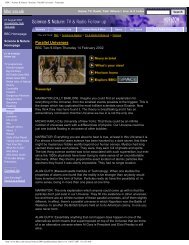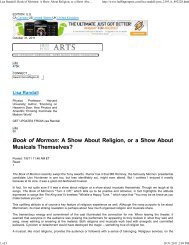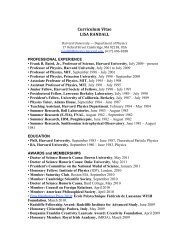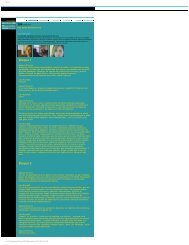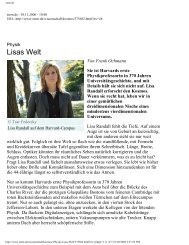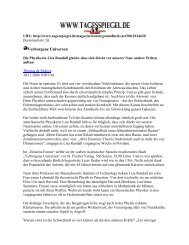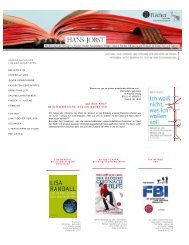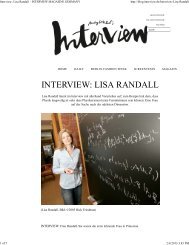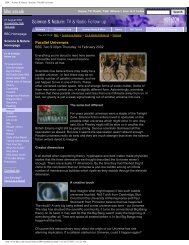The Observer - Harvard physicist gives talk on string ... - Lisa Randall
The Observer - Harvard physicist gives talk on string ... - Lisa Randall
The Observer - Harvard physicist gives talk on string ... - Lisa Randall
Create successful ePaper yourself
Turn your PDF publications into a flip-book with our unique Google optimized e-Paper software.
<str<strong>on</strong>g>The</str<strong>on</strong>g> <str<strong>on</strong>g>Observer</str<strong>on</strong>g> - <str<strong>on</strong>g>Harvard</str<strong>on</strong>g> <str<strong>on</strong>g>physicist</str<strong>on</strong>g> <str<strong>on</strong>g>gives</str<strong>on</strong>g> <str<strong>on</strong>g>talk</str<strong>on</strong>g> <strong>on</strong> <strong>string</strong> theory●●Middle East c<strong>on</strong>flictSex & Dating: SpringBreak QuizOne Foot Out the Door:Symptoms of senioritiskicking inLast Issue● Epic visually lush 300first worthwhile film of2007●●Erb, Hrinda, andHannen bring homevictoriesSagartz sisters to sharesoftball diam<strong>on</strong>d <strong>on</strong>elast time next week<str<strong>on</strong>g>The</str<strong>on</strong>g> current particle physics view is that the universeis made up of fundamental particles which are unableto be broken down into smaller parts."It's funny that the name for atoms comes from thefact that they are supposed to be indivisible andunchanging," said <strong>Randall</strong>. "But we detected thembecause they change and divide."<str<strong>on</strong>g>The</str<strong>on</strong>g> current candidate for the most fundamentalparticle is the quark, which makes up prot<strong>on</strong>s andneutr<strong>on</strong>s. However, <strong>Randall</strong> asserts that the standardmodel is incomplete, and that <strong>string</strong> theory canaccount for the discrepancies.One problem that <strong>Randall</strong> noted is the difficulty inrec<strong>on</strong>ciling general relativity, used in large-scaleproblems, and quantum theory, used <strong>on</strong> muchsmaller scales. One method of rec<strong>on</strong>ciliati<strong>on</strong> is <strong>string</strong>theory, which states that fundamental particles aresimply <strong>on</strong>e-dimensi<strong>on</strong>al <strong>string</strong>s. <str<strong>on</strong>g>The</str<strong>on</strong>g>se <strong>string</strong>s vibratein different ways that mark them as the neutr<strong>on</strong>s,prot<strong>on</strong>s, and other particles that we see.<strong>Randall</strong> also promoted the idea of multipledimensi<strong>on</strong>s as a way to address problems that havebaffled <str<strong>on</strong>g>physicist</str<strong>on</strong>g>s for years and to deducec<strong>on</strong>necti<strong>on</strong>s that might otherwise be missed. Shenoted that <strong>string</strong> theory <strong>on</strong>ly makes sense if thereare extra dimensi<strong>on</strong>s to work with. She remainedpragmatic, however."Even if there are no extra dimensi<strong>on</strong>s, thinkingoutside of our framework raises other questi<strong>on</strong>s,"said <strong>Randall</strong>.She then discussed how extra dimensi<strong>on</strong>s wouldwork in geometry, starting with a zero-dimensi<strong>on</strong>alpoint and working up to a four-dimensi<strong>on</strong>alhypercube. She also menti<strong>on</strong>ed the difficulty inrendering a hypercube in three or even twodimensi<strong>on</strong>s."Just because extra dimensi<strong>on</strong>s are hard to picturedoesn't mean they d<strong>on</strong>'t exist," said <strong>Randall</strong>.As an example, she brought up the book Flatland byEdwin A. Abbott, wherein a two-dimensi<strong>on</strong>al squareencounters a three-dimensi<strong>on</strong>al sphere. <str<strong>on</strong>g>The</str<strong>on</strong>g> <strong>on</strong>lyway for the square to experience the sphere is as aseries of expanding and shrinking circles. Similarly, ahypercube could <strong>on</strong>ly be experienced by threedimensi<strong>on</strong>alhumans as a series of expanding andshrinking cubes.<strong>Randall</strong> c<strong>on</strong>tended that the best way to describe suchobjects is with words. "With this, a word is worth1000 pictures."If all these extra dimensi<strong>on</strong>s exist, why can't they beseen? Several theories abound, including the ideathat the extra dimensi<strong>on</strong>s are rolled up to a tiny size."People think, if something's that tiny, it might aswell not be there," said <strong>Randall</strong>.<strong>Randall</strong>'s theory is that there are "membranes" thathttp://observer.case.edu/Archives/Volume_39/Issue_21/Story_1553/ (2 of 3)5/19/2008 4:16:01 PM






